|
|
Original Problems (page -8)I’ll publish some of my problems here and I’d be happy to receive yours! Diagrams, comments, new ideas, anything to discuss – are very appreciated! The site is mostly about fairies, but h# and s# are also welcome! Please send your problems to my e-mail: julia@juliasfairies.com Go to >>> Page 7 ; >>> Page 9 |
Opening this page, I’m happy to welcome at the site 2 new authors, who are also well-known on the world’s composition arena, with a joint problem:
No.26 – h#2 by S. K. Balasubramanian (India) & Pierre Tritten (France) – a very nice joint problem which demonstrates an interesting idea with mates by white Locust using KoBul Kings condition for Black only. Here I’d like to make an accent on the fairy condition once again: it is KoBulKing Black! So, the changes described in KoBul Kings term are applied to the black King only.
No.27 – enjoy another problem by S. K. Balasubramanian (India) – h#2 with a combination of 2 fairy conditions: the very old one – Madrasi, and the very new one – Kobul!
I’m happy to announce that 3 authors have agreed about publishing a new version of the problem No.26 as their joint problem!
No. 26.1 – by Petko A.Petkov (Bulgaria), S. K. Balasubramanian (India), Pierre Tritten (France) (first, on 22-jun, 2 joint versions – A & B – were published, but later authors have came to the one you can see now)
I believe, we can have some other joint problems in the future looking for the best versions if all the authors are agree.
See all Definitions in Fairy Terms section or click the fairy piece or condition below to go right to its definition on that page:
|
–
No.26 S. K. Balasubramanian &
Pierre Tritten
(India / France)
original
–
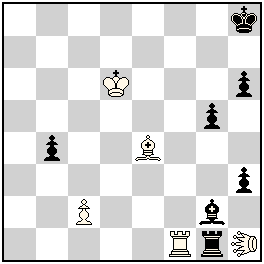 h#2 2 solutions (5+7)
White Locust h1
KoBulKing Black
–
Solutions:
1.rKg8 Bd3 2.Bb7 LO×b7-a8 [brK=rB] # (3.rB-f7/e6/d5/c4/b3/a2?)
1.rKg7 Rf8 2.Rb1 LO×b1-a1 [brK=rR] # (3.rR-h7/f7/e7/d7/c7/b7/a7?)
–
The important thing we wanted to show in that problem was that the brB cannot move to any square along the diagonal a2-g8 when the white Locust is checking on a8 and the brR cannot move to any square along the 7th rank (a7-h7) when checked by white Locust on a1.(Authors).
Mates by white Locust after thematic sacrifices of black B/R on b7/b1. The sacrifices change phase of the black King to Bishop / Rook and in these phases it gets surprising mates on g7/g8. Line-openings for the black thematic pieces in the whites’ first moves. Pay attention, that the KoBul Kings conditions is only partial here – it works for the black King (black side) only! (Editor)
|
–
No.27 S. K. Balasubramanian
–
(India)
original
–
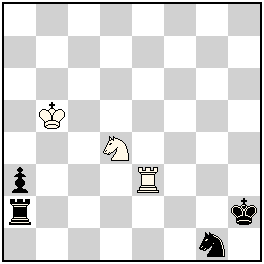 h#2 2 solutions (3+4)
Madrasi Rex Inclusive
KoBul Kings
–
Solutions:
I. 1.Re2 Sxe2 [brK=rR] 2.rRxe2 [wrK=rS] rSc3 (rSd4?) #
II. 1.Sf3 Rxf3 [brK=rS] 2.rSxf3 [wrK=rR] rRf5 (rRb3?) #
–
Features: 1. Exchange of roles by WR & WS and by BR & BS. 2. In each solution paralysis occurs thrice and paralysis is broken twice during the solution and the mating dual avoidance move is by avoiding another paralysing effect. 3. Dual avoidances by white’s mating move. (Author) |
|
–
No.26.1 Petko A.Petkov,
S.K. Balasubramanian &
Pierre Tritten
(Bulgaria / India / France)
original
–
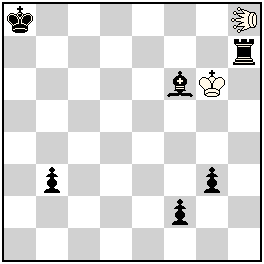 h#2 2 solutions (2+6)
White Locust h8
KoBul Kings
–
Solutions:
I. 1.Rh2 Kxf6 (Ka8=rB) 2. rBg2 LOxh2-h1 (rB=rR) #
II. 1.Bb2 Kxh7 (Ka8=rR) 2.rRa2 LOxb2-a1 (rR=rB) #
–
White Minimal-problem in which both Kings have thematic role. The white King captures bB and bR and determines changes of the black King. The black King is twice modified with reciprocal effect – in I solution: K – rB – rR, in second solution: K – rR – rB! This play in the four corners of the board leads to the nice fairy model-mates in which the white Locust also demonstrates its power. Probably, this complex is shown for the first time in KoBul Chess genre! (Authors)
|
The diagrams are made on WinChloe and its Echecs font is used for Logo design



No.26. Very nice idea. That the black king gets a lot of squares to move in both solution and still gets mated is of course interesting. But what I find more interesting is that because of conversion as bishop, the black king cannot move to h8 to avoid mate. This effect is there in the first solution. Unfortunately, h8 is guarded by WR in the second solution and hence that effect is lost in the second solution.
Dear Seetharaman,
Thanks for your comments. Your are right. The square h8 is guarded by WR in the second solution. I could not avoid it as g8 has to be guarded and this cannot be a static guard as BK has to arrive on g8 in the first solution. I will see whether it can be improved.
—-Bala
You are right Bala ! That is why I said ‘unfortunately’.
No.26. Very good problem. I like it! BTW I have to note that Popeye and WinChloe can solve problems of type only Black or White KoBul King, so everything is fine here.
Diyan,
This is something I’ve studied as well, receiving this problem. I didn’t know that popeye has a separated conditions for the white and black King as well as a joint condition. Mr.Balasubramanian has kindly sent me the input for popeye for his problem – so I’ve got the right condition! 🙂 I didn’t find it in popeye manual, but seems like there’re 2 options for adding KoBul Kings condition:
1) Condition=KoBul (the word “Kings” after that is optional and doesn’t have any sence in a solving) – this works for the both Kings;
2) Condition=KoBulKing Black / KoBulKing White – this works for either black or white King
Am I right? Is there anything also maybe?
About WinChloe – yes, it never had a joint condition, but has a separated conditions for the both Kings, so the both can be applied together, or just one of them (like in a problem No.26)
Myself, I’d prefer the both Kings to be KoBul Kings in one problem. /julia
About N 26 – S. K. Balasubramanian &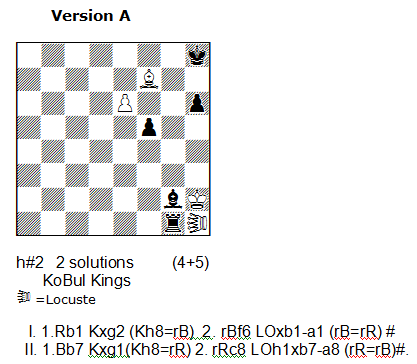 [/img]
[/img]
Pierre Tritten.
A nice problem! Every half-move here demonstrates some interesting motive: line – opening, sacrifices of black B/R on b7/b1, fine key-moves of Black and good transformation of black K in B/R – royal phases!
But in my opinion, there are here also some significant weaknesses. I agree that in the second solution the control over “h8” is a weakness, of course. It seems inevitable in this version.
The worst is, that the black Bishop plays only in the first solution (here the Rg1 is surplus) and the black Rook plays only in the second solution (here the Bg2 is surplus). This phenomenon often occurs in helpmate – genre, but here it seems uncomfortable.
Another question is the partial use of KoBul condition (only for Black). It is of course possible, but I think that this condition has a greater impact when it affects both Kings. And finally – in this problem the condition is demonstrated only on the last half-move and it seems insufficientt. Deficiency of KoBul – effects is obvious.
It is interesting that in this scheme can be used topically (a la KoBul!) the white king, and also – to use more active black Bishop and Rook. As example I demonstrate two of many possible versions:
[img
In Version A the black King is twice modified with reciprocal effect – in I solution: K – rB – RR, in second solution: K – rR – rB! There is here also interchange of functions between black B and R – an very important ellement which absent in the initial problem.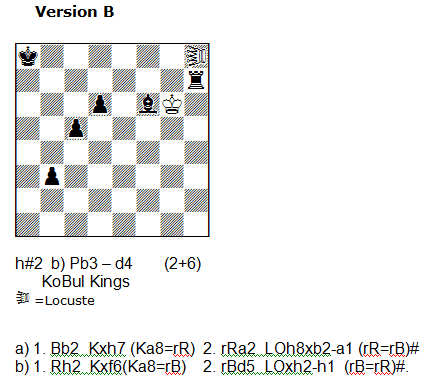 [/img]
[/img]
If we work with twins, it is possible more economical position:
[img
Of course, these versions are somewhat far from the initial Co – problem. But they used the same basic mechanism – a play in the four corners of the board, in one of them stands the white Locust which capture black R and B. Many other modification of this idea are possible , even in 2.5 and 3 moves.
Very instructive improvement of the problem. The idea of using white king capturing the idle black piece in each solution is an important idea. The problem is now outstanding. Version B is also my preference, because black king travels longer 🙂
Dear Mr. Petko,
Many thanks for your analysis of our problem and suggesting how to avoid the weaknesses. I know that there were weaknesses in the problem. Actually as Mr. Nikola Predrag said, I was aiming only at making the BK mobile along the entire diagonal and along the entire rank. It was not working. Mr. Pierre made it to work by chosing only BK as Kobul King.
Your version A is very good. I like it. It is my fortune that I got an opportunity to learn from an expert like you how to improve the idea.
—Bala
Julia – yes, Mr. Stephen Emmerson added into Popeye also option to check only white or black KoBul King problem. This can be done by addind “white” or “black” after the condition. Input file for example:
cond: kobulk white
About Petkov’s version of problem n.26 – they are very good improvements. I prefer “Version B” even that it is with twin form, because it is white minimal and on the diagram are only thematic pieces. Great!
No.26. The original joint problem clearly suffers from the half-employed parts of the mechanism and also some other weaknesses. Versions A and B show how the perfect FORM should look but they do not improve the IDEA, they distort the most exciting paradoxical feature related to the KoBull condition. Black Royal piece in a phase of a King has the smallest mobility in the corner. But it can not be mated there. It must paradoxically transform into the long-range piece, having a long free line and only then it could be mated.
Playing obviously the worse move (to get imprisoned by own Pawns) is, of course, typical for helpmates. But the question is – “what is the essence of some idea – the form or the logic”? The author is entitled to choose the preference.
Real improvement of formal weaknesses should retain the paradoxical logic. In this problem, the first formal improvement I would care about, would be the model mates – it is closely related to the logic (if I’m not wrong, only the square d5 in the first solution is guarded twice).
Anyway, the authors know what was their idea and the spectators may not like it and may prefere a diferent content.
I thought that the paradox of the black King with limited mobility getting transformed into long range piece to get mated is still there in versions A & B also.
Yes, but only before the 2nd black move and then Black play to a square where it will be imprisoned after the KoBul transformation. By the last mating capture, White changes a rather mobile Royal piece into a rather immobile one.
In the original, a rather immobile bK is changed into a rather mobile Royal piece as the very last effect of the very last move of each solution,. A good surprise which comes at the very end of some story is a challenge to achieve.
Good point, which I missed !
Dear Mr. Nikola Predrag,
Thanks for your comeents. As you have pointed it out, my main idea was to show the mobility of BK to all possible diagonal & orthogonal squares in the two solutions. So, I sacrificed the other things and I don’t know whether that is justified or not. I don’t know how to improve it without sacrificing my idea.
—Bala
Dear friends, to all the comments to the problem No.26 which are at the top of hierarchy, I’ve added “No.26” as now one more problem, No.27, is added to the same page. /julia.
No.27 S. K. Balasubramanian – А very nice miniature which demonstrates a patent idea on this strange and almost unknown fairy – field! The fine aesthetic of Professor Bala makes us happy again!
Perhaps, it would be better if the position is raised by two horizontals (Kb7/Kh4). In the new position the black Rook and the Knight have greater mobility. But it is a micro detail and it reflects a subjective opinion.
I am convinced that there are opportunities to develop this idea. It is reasonable to assume, that there are two ways to achieve this goal:
a) use of another duet of thematic figures (for example: S/B B/R,B/Nightrider, etc);
b) realization in more than 2 moves (for example: H#2.5, H#3…).
Dear Mr. Petko,
Thanks for your kind and encouraging comments. I am not able to understand your suggestion of keeping Kb7/Kh4. If you don’t mind, can you kindly explain further?
Regarding your other suggestion of using another duel, already I have used B/R duel and it has been accepted for publication in Strate Gems which is a joint composition with Mr. Seetharaman. In that problem, we have used only 6 pieces (K,B,R of each colour) and achieved dual avoidance by both white and black. I have not tried B/N and other combinations.
Regarding making it as H#2.5, H#3, I will try.
Many thanks for giving me fresh ideas.
Regards,
Bala
Dear Mr. Petko,
Sorry, I could understand what you meant by Kb7/Kh4. Your suggstion is to shift all pieces 2 squares up. Always I try to keep the pieeces mostly in the centre of the board. I shift the pieces to one side of the board only to imrpove the economy. I don’t know how I missed this setting (Kb7/Kh4). Thanks for your kind and useful suggestion.
—- Bala
Dear Mr. Balasubramanian,
You’ve had an idea and found the mechanism that shows it pretty clearly in Meredith form. Enough for an interesting problem. If you insist on keeping the lines of Royal piece completely free, you probably must sacrifice many other things. The basic idea can be realized with less pieces but your relization is obviously much better. Rough example:
White La6 Kd6 Sg4 Bc2
Black Kg8 Pg5 Bh4 Rg2
H#2 Twin Move g4 h6
What the Grand-Grandmaster has shown is a balance between the idea and the mechanism. You and Pierre invented a mechanism good, but not perfect for the idea. Mr.Petkov noticed the full potential of the mechanism, adjusted the idea and presented a perfect balance. All elements of the mechanism are mutually related and fully employed, including the KoBul condition.
(Prob No.26)
Dear Mr. Nicola Predrag,
Thanks for your comments and suggestions. It seems that there is a cook in (b) in your suggested version. Further, there is some lack of unity between the solutions of the two phases.
Regarding Mr. Petko’s version — Yes. It is a great one, showing the idea. No.26 is the firstever problem I composed (later Pierre joined) using Locust. Initially I started with simple idea of using locust with orthogonal and dioganal echoes. In the process I thought to make the entire diagonal and the rank free for BK, which I could achieve only by using half Kobul King condition. Since our main focus was different, it had many blemishes.
—-Bala
Nice problem Bala, using your earlier (patented?) idea. It is good that white has a choice of checks on the mating move and only one of them works !
No.27:
Dear Seetharaman,
Thanks for your comments.
—- Bala
(Prob.No.26)
Dear Mr. Balasubramanian,
my rough example is certainly no suggestion. On the contrary, I wanted to show the importance of a good and clear mechanism. In the example, the idea is realized with 4+4 pieces but WITHOUT ONE CLEAR MECHANISM. Various elements, used to define the order of moves do not make a unique mechanism. The attempt to make a twin b)Bc2->e4 allows dualistic order of moves. Different twinning b)Sg4->h6 disables this dual because bK is in check. Such an ugly way to save the correctness of the problem is generally unacceptable.
By such a contrast I wished to show that the original No.26 presents a good mechanism. Not excellent but acceptably efficient. for the demanding idea. Compared to many problems in the magazines and awards, I don’t think that your problem has many or big blemishes.
Dear Mr. Nikola Predrag,
Thanks for your explanation and encouragin comments abour our problem.
—- Bala